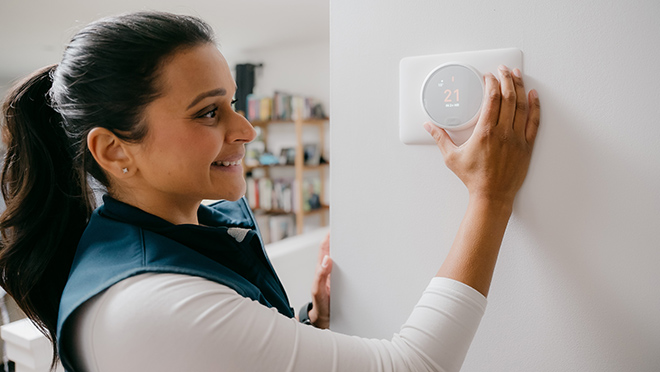Where to set the thermostat? It's personal

Five ways to bring peace (and comfort) to your home
You walk into a friend's home on a cold winter day and suddenly feel the need to strip down to a tee shirt. Or you arrive home to find that your partner, roommate, or family member has lowered the thermostat to the point that your home feels like a meat locker.
These scenarios happen to just about everyone, and a string of studies have shown just how personal home temperature preferences are. They vary from home to home, room to room, and person to person. And sometimes, temperature arguments can lead to a cold shoulder or get downright heated.
A 2021 BC Hydro report found that more than 80% of British Columbian couples complain about the temperature in their home to their partner, with 40% saying it happens at least once a week, and more than one seven saying there's a daily complaint.
Given personal preferences around temperature, how do you find comfort and peace at home? Here are a few suggestions.
1. Set your thermostat to your activity level
Notice how much more warmer your home feels after you return from the gym or a walk, or while you're active doing housework? Use that knowledge to help you tweak indoor temperature to your activity levels.
If you're in a home equipped with the year-round comfort afforded by a heat pump, stick to the strategy of set it and forget it, which is the go-to for efficiency and comfort. But if you have electric baseboards, only heat the rooms you're using, and according to what you're doing in the home.
Our oft-repeated guideline is to set the temperature at 18°C while you're in the kitchen or active in the home, and at 21°C when you sit down to read or watch TV. It's a general guideline, and there will be some negotiation if only one of you is active (or on the couch). But keep it in mind, monitor your thermostat, and avoid conflict with your roommates by dressing to hit your comfort level.
Consider upgrading to smart thermostats if you don't already have them. You can get instant rebates $100 off bundles of three eligible smart thermostats, $50 off packs of two units, or up to $25 off single thermostats at select retailers from October 6, 2023, to January 26, 2024.
2. Dress for success
With one eye on your home energy bill and another on the happiness of others in your home, personalize how you dress as the path to personal comfort. If you're feeling a chill, layer up with a hoodie or sweater, wear thick socks or a slippers, and if you're on the couch, use a blanket.
Too warm? If you're home alone, turn down the thermostat. And if you're not, peel off a layer.
3. Find your comfort level in bed
We recommend lowering or programming your home temperature overnight (and when you're not at home) to 16°C. But while many of us find it easier to sleep at lower temperatures, some of us need warm pajamas and/or a really warm blanket to find the right temperature.
A 2020 Good Housekeeping story suggested that separate bedding – as opposed to separate beds – might avoid a "sleep divorce". It quotes experts who said that if you're in a nightly tug of war for the duvet – or are regularly interrupted by a partner's attempts to warm up – you may want to try separate duvets/blankets and/or top sheets.
Oh, and if you or your partner insists on opening the window a crack for fresh air in winter, turn the heat off and close the bedroom door. Otherwise, your heat will go right out the window and your energy bills will rise.

4. Use MyHydro to see how your energy use compares
How does your home heating use stack up against others?
One way to check is to log in to your MyHydro account on bchydro.com and check your electricity usage. Select the "compare to similar homes" to get a graph showing how your daily, weekly, or monthly usage compares to those who live in similar-sized homes nearby. While there are other factors at work in energy use, if your home is electrically heated – especially with baseboard electric heaters – there's a good chance your usage and bills are highly dependent on where you set your thermostat.
Change the comparison to "outside temperature" and, if you're electrically heated, you should see a corresponding bump in your energy use as temperatures get lower. Those spikes become more pronounced in poorly-insulated or drafty homes, and/or in homes with inefficient heating.
That's one reason many British Columbians, both with electric baseboards and natural gas heat, are taking advantage of rebates to switch to electric heat pumps. Not only do they provide more comfortable, efficient heating in the cold months, they also offer efficient cooling in the summer. Use our heat pump savings calculator to get an idea of how you might save by making the switch.
Learn more about tracking and managing your energy use online.
5. Check to ensure drafts aren't the source of discomfort
Two things happen when leaks around windows, doors, and even plug and light outlets, cause drafts in the home. One is that you're finding cool spots (an even colder, moving air) in different areas of your home. The other is that your energy bills are higher than they should be.
Draftproofing – also known as weather stripping – is one of the simplest and most affordable ways to improve your home's energy efficiency. It's relatively easy to do, doesn't cost much, and can have a huge payoff.
Learn more about draftproofing, and see our how-to videos.
There's also a chance you have bigger problems than leaky windows and doors. If your home isn't well insulated, consider taking advantage of home renovation rebates of up to $1,200 for upgrades to attics, exterior walls, and more.
Related: